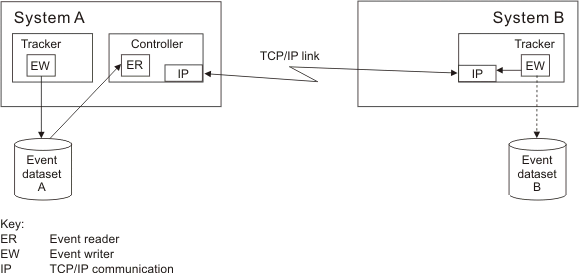Controlling a z/OS system through a TCP/IP link
Controlling a z/OS system through a TCP/IP link shows a z/OS system connected to the HCL Workload Automation for Z host via a TCP/IP link.
You represent each system by a computer workstation. The destination field in the workstation description for System A is left blank. Work for this workstation is started on System A. The destination field for the System B workstation contains the destination name associated with the IP address of the tracker on this system. Work is transmitted from the host to the tracker and is then initiated on System B.

On System A, an event writer writes events to event data set A, which is read by an event reader subtask at the controller. On system B the tracker event-writer subtask is started with a reader function, EWSEQNO is defined in the EWTROPTS statement. This means that the event writer passes the events to NCF for transfer to the controller at the same time as they are written to the event data set.
Automatic workload restart can be used in this configuration if the controller cannot communicate with the tracker on system B. The status of the workstation for System B is set to offline if z/OS is stopped or fails, if the tracker is stopped or fails, or if the link is lost. WLR actions are taken according to the WSOFFLINE keyword of the JTOPTS initialization statement.
Example EQQPARM Members for the previous figure shows the initialization statements you can use to create the configuration in Controlling a z/OS system through a TCP/IP link.
| EQQPARM members for System A | |
|---|---|
|
CONTROLR
|
TRACKERA
|
|
ERDR1
|
TRKAEW
|
|
EQQPARM members for System B |
|
|
TRACKERB
|
TRKBEW
|